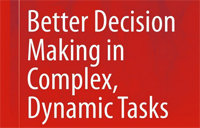 Computer simulation-based education and training is a multibillion-dollar industry, but research has shown that when it comes to training for decision-making, people often perform poorly. A new book by York Professor Hassan Qudrat-Ullah looks at why that is and how to improve outcomes.
Computer simulation-based education and training is a multibillion-dollar industry, but research has shown that when it comes to training for decision-making, people often perform poorly. A new book by York Professor Hassan Qudrat-Ullah looks at why that is and how to improve outcomes.
With rapid advancements in technology and the increased complexity of organizational decision-making, the demand for decision aids in training is expected to increase. The book, Better Decision Making in Complex, Dynamic Tasks:Training with Human-Facilitated Interactive Learning Environments, looks specifically at decision-making and learning with interactive learning environments. It is part of Springer’s Understanding Complex Systems series.
Qudrat-Ullah says the book describes interactive learning environments (ILEs) and their underlying concepts, and introduces decision-making in dynamic tasks. It also explains the methods and obstacles of training with human-facilitated, simulation-based learning environments.
“The objective of this book is to enhance our understanding of and to gain insights into the process by which human-facilitated ILEs are effectively designed and used in improving users’ decision-making in complex, dynamic tasks,” says Qudrat-Ullah, a professor in the School of Administrative Studies in the Faculty of Liberal Arts and Professional Studies.
At the moment, when it comes to people’s training for decision-making in “dynamic tasks,” effectiveness of ILEs is limited at best. A large of body of empirical research indicates that during sessions with ILEs, people perform poorly on “dynamic tasks.” They do not develop adequate models of the task system.

In writing the book, Qudrat-Ullah says they developed an integrated process model based on an extensive review of empirical research and practice of dynamic decision-making. Human facilitation was incorporated in the design of an ILE to facilitate the acquisition of multidimensional learning outcomes. That includes understanding of the task structure, system behaviour and the relationship between the two – improving decision-making in dynamic tasks.
The book’s information is divided into four different parts. Part I introduces the reader to the importance and complexity of decision-making in dynamic tasks. Part II provides background material, drawing on relevant literature, for the development of an integrated process model on the effectiveness of human-facilitated ILEs in improving decision-making in dynamic tasks.
Part III focuses on the design, development and application of FishBankILE in laboratory experiments to gather empirical evidence for the validity of the process model. Part IV presents a comprehensive analysis of the gathered data to illustrate the lessons to be learned.
In the foreword of this book, Professor Khalid Saeed, WPI, USA, writes, “This book is a stand-alone volume that explains the interactive learning environments, how they can be used to improve decision-making processes, and how the improvements they create are scientifically verified. It is a must read both for system dynamics practitioners and those seeking evidence for the efficacy of its use in decision-making.”


